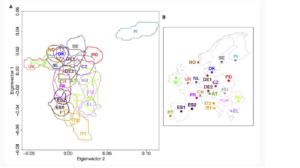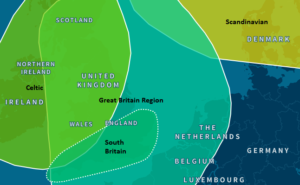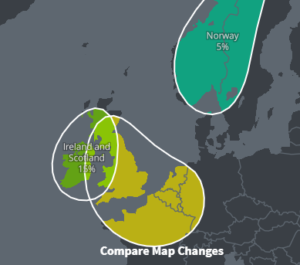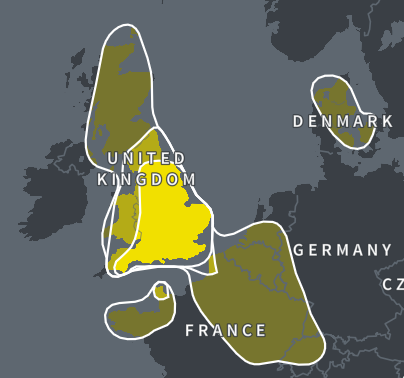One other feature provided by the Ancestry DNA autosomal test is determining the geographic origin of your ancestors; however, while this feature is frequently cited in their advertisements it needs to be put into context. This type of estimate is possible since in pre-industrial societies people generally married within their cultural/ethnic/geographic groups. Due to the mixing of DNA with each generation certain autosomal genetic markers spread through the population so for example people from Germany have different markers than those from Italy.
The DNA testing companies use statistical analysis of Markers (SNP) in the DNA to relate these to geography (see: https://www.newscientist.com/article/dn14631-human-geography-is-mapped-in-the-genes/ ) to determine your origin. The more genetically different the people from different regions are the easier it is to pinpoint origins. The following diagram and map shows how people from different European countries differ using one of these methods:

Source: http://www.cell.com/current-biology/fulltext/S0960-9822(08)00956-1
The DNA clusters (on left) are associated with different countries (see codes on right).
When a DNA testing company says you are 50% German and 50 % Italian it means that those are the proportion of these specific markers in your autosomal DNA. This could reflect that one of your grandparents had roots in Germany and the other in Italy. One important point to remember is that there are a limited number markers used to identify country of origin and these markers may not be passed on in the same proportions to different children. In the example above another child of this couple might test as 70^% German and 30 % Italian which would indicate that this child inherited more German markers (see example).
When I first did the Ancestry DNA test in 2012 it identified me as 41% Scandinavian, 31% Celtic (Ireland, Scotland and Wales) and 15% British (see newer results in update below). My Newell relatives should note that these Ancestry test use autosomal DNA and these results include DNA from my mothers side (e.g. Norman, Snelgrove, erc. families) plus my fathers mother’s family (Andrews etc.) and all other earlier non Newell ancestors so their country of origin autosomal results will differ from these since their non Newell ancestors will differ from mine.
Around the same time I did the National Geographic DNA test (Geno 2.0) which used a different methodology to identify the geographic origins of my ancestors. This test identified my closest matching region as Germany and my second matching region as Denmark (National Geographic only gives two regions). The National Geographic results are significantly different from the Ancestry results; however, this difference may be explained by differences in methodology. The National Geographic test was focused on identifying deep (distant) ancestral origins while the Ancestry test is focused on identifying the origins of your recent ancestors. Basically the National Geographic reference populations give a snapshot of how similar you are to people alive today living in certain countries.
Some countries have relatively unique DNA signatures (e.g. Poland and Italy); while others overlap. DNA signatures for the UK, the Netherlands, Denmark and Northern Germany are relatively similar. The UK and Ireland have some genetic components that are unique and some that are shared with their Northwest European neighbors. This pattern of DNA for the UK reflects the different groups of people (Ancient Britons, Celtic, Anglo-Saxon, Danish, Viking, Norman French, etc) that make up the population of the UK (See: http://www.telegraph.co.uk/science/2016/03/14/britons-still-live-in-anglo-saxon-tribal-kingdoms-oxford-univers/ ). DNA from northwest Europe (Germany, Denmark and Belgium) can account for over 40% of the DNA in parts of the UK. Ireland has a slightly less varied DNA profile with a larger Celtic component, a Scandinavian component from the Vikings and later (post 1500) DNA from the UK.
It should also be noted that at that time the Ancestry region for Britain includes Normandy, Belgium, the Netherlands and the NW Rhine in Germany (see Map below) and these areas overlap with the National Geographic German region.

Therefore, the differences between the two test likely reflect the differences in methodology for selecting regions.
Within the Great Britain region Ancestry identified a focus on the south coast of Britain. This is not surprising since many of my ancestors trace their roots back to Dorset, Devon and the Channel Islands. Ancestry also identified links between my ancestors and New England and Nova Scotia and states that Nova Scotia & Massachusetts are “specific places in this region where your family might have lived“. This latter remark is especially interesting given the earlier analysis of my 5th cousin Newell and Knowles matches.
In September 2018 I got a message from Ancestry stating that: your DNA doesn’t change, but genetic science does. With 5x more reference samples and more regions around the world, your updated results are more detailed and precise than ever. Apparently, Ancestry is using new data and a newer methodology and revised regions to determine origins. My new results are below:
As part of the new process Ancestry revised their regions and the one that I had a 80% match with was called England, Wales and Northwestern Europe. My match to this region increased from 15% in the initial results; however, this region now includes more of northwestern Germany and northern France (including the French / German border along the Rhine). This provides an even better match to the regions covered by my National Geographic DNA results.

However, the story continues to change and in October, 2019 I got another message from Ancestry indicating that my results have been updated again. We recently added more ethnicity populations and communities. Based on this update, you might see changes to your results. After this change my results are:
- England, Wales & Northwestern Europe 81%
- Ireland & Scotland 15%
- Germanic Europe 4%
The following map shows what Ancestry defines as “England, Wales & Northwestern Europe”:

Ancestry states that my results for this Region are primarily located in: Belgium, Channel Islands, England, Wales (see highlighted area) . The other change in this update was that my 5% Norwegian ancestry was now German! The German match is focused on the Schwaben region of southern Germany and Ancestry states that: your [German] ethnicity estimate is 4%, but it can range from 0—11%.
The most recent Ancestry update was in 2020 and it provided more detail on the various ethnitic groups within the UK (see below).
After this update my new ethnicity estimates (below) made me more Celtic (37% Scottish and Welsh) and the 5% Norwegian component returned.

Comparing my results with those for my sister (Shirley Badcock) demonstrates that they are relatively similar with my sister having a slightly higher Scottish component and 7% Swedish component versus my 5% Norwegian. This difference in the Nordic component may simply reflect the difficulity of seperating the DNA from these two groups of Nordic people.

The background information that Ancestry provided with this update gives the typical ethnicity profile for someone from England (see below).

This suggest that while my profile is generally similar to someone from England (see above) it is perhaps a bitter fit for someone from the northeast of England. (see below).

One other component that Ancestry provides as part of its Ethnicity Estimates is a list of Genetic Communities that are groups of AncestryDNA members who are connected through their DNA. This is probably because they descend from a population of shared ancestors, from a particular place and time. The Communities that Ancestry currently links me to are listed below.

The Newfoundland and Northern New England communities are not surprising given the strong historical connections between Newfoundland and New England; however, the Acadian connection is a surprise. I have recentely been investigating these French Connections.